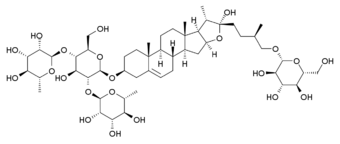Protodioscin
 | |
| Clinical data | |
|---|---|
| Routes of administration | Oral |
| ATC code |
|
| Legal status | |
| Legal status |
|
| Identifiers | |
| |
| CAS Number | |
| PubChem CID | |
| ChemSpider | |
| Chemical and physical data | |
| Formula | C51H84O22 |
| Molar mass | 1049.199 g/mol |
| 3D model (JSmol) | |
| |
| |
| (verify) | |
Protodioscin is a steroidal saponin compound found in a number of plant species, most notably in the Tribulus, Trigonella and Dioscorea families.[1][2][3] It is best known as the putative active component of the herbal aphrodisiac plant Tribulus terrestris.[4]
Extracts from T. terrestris standardised for protodioscin content have been demonstrated to produce proerectile effects in isolated tissues and aphrodisiac action in several animal species.[5][6] It is thought protodioscin achieves this primarily through causing an increase in androgen receptor immunoreacivity, meaning it increases the concentration of androgen receptors in cells, causing the organism to become more sensitive to androgens like testosterone and DHT.[7] The mechanism for these effects has not been clearly established, and while protodioscin has been demonstrated to trigger release of nitric oxide in corpus cavernosum tissue,[8] and also to produce statistically significant increases in the levels of the hormones testosterone, dihydrotestosterone and dehydroepiandrosterone in animal studies,[9] studies in humans have failed to show efficacy and its use remains controversial.[10][11]
References
- ↑ Ganzera M, Bedir E, Khan IA (2001). "Determination of steroidal saponins in Tribulus terrestris by reversed-phase high-performance liquid chromatography and evaporative light scattering detection". Journal of Pharmaceutical Sciences. 90 (11): 1752–1758. doi:10.1002/jps.1124. PMID 11745732.
- ↑ Hibasami, H; Moteki, H; Ishikawa, K; Katsuzaki, H; Imai, K; Yoshioka, K; Ishii, Y; Komiya, T (2003). "Protodioscin isolated from fenugreek (Trigonella foenumgraecum L.) induces cell death and morphological change indicative of apoptosis in leukemic cell line H-60, but not in gastric cancer cell line KATO III". International Journal of Molecular Medicine. 11 (1): 23–6. doi:10.3892/ijmm.11.1.23. PMID 12469212.
- ↑ Dong, M; Feng, XZ; Wang, BX; Ikejima, T; Wu, LJ (2004). "Steroidal saponins from Dioscorea panthaica and their cytotoxic activity". Die Pharmazie. 59 (4): 294–6. PMID 15125576.
- ↑ Dinchev, D; Janda, B; Evstatieva, L; Oleszek, W; Aslani, MR; Kostova, I (2008). "Distribution of steroidal saponins in Tribulus terrestris from different geographical regions". Phytochemistry. 69 (1): 176–86. doi:10.1016/j.phytochem.2007.07.003. PMID 17719068.
- ↑ Gauthaman, K; Adaikan, PG; Prasad, RN (2002). "Aphrodisiac properties of Tribulus Terrestris extract (Protodioscin) in normal and castrated rats". Life Sciences. 71 (12): 1385–96. doi:10.1016/S0024-3205(02)01858-1. PMID 12127159.
- ↑ Gauthaman, K; Ganesan, AP; Prasad, RN (2003). "Sexual effects of puncturevine (Tribulus terrestris) extract (protodioscin): an evaluation using a rat model". Journal of alternative and complementary medicine. 9 (2): 257–65. doi:10.1089/10755530360623374. PMID 12804079.
- ↑ Gauthaman, K; Adaikan, PG (2005). "Effect of Tribulus terrestris on nicotinamide adenine dinucleotide phosphate-diaphorase activity and androgen receptors in rat brain". J Ethnopharmacol. 96: 127–32. doi:10.1016/j.jep.2004.08.030. PMID 15588660.
- ↑ Adaikan, PG; Gauthaman, K; Prasad, RN; Ng, SC (2000). "Proerectile pharmacological effects of Tribulus terrestris extract on the rabbit corpus cavernosum". Annals of the Academy of Medicine, Singapore. 29 (1): 22–6. PMID 10748960.
- ↑ Gauthaman, K; Ganesan, AP (2008). "The hormonal effects of Tribulus terrestris and its role in the management of male erectile dysfunction--an evaluation using primates, rabbit and rat". Phytomedicine. 15 (1–2): 44–54. doi:10.1016/j.phymed.2007.11.011. PMID 18068966.
- ↑ Rowland, DL; Tai, W (2003). "A review of plant-derived and herbal approaches to the treatment of sexual dysfunctions". Journal of sex & marital therapy. 29 (3): 185–205. doi:10.1080/00926230390155096. PMID 12851124.
- ↑ McKay, D (2004). "Nutrients and botanicals for erectile dysfunction: examining the evidence". Alternative Medicine Review. 9 (1): 4–16. PMID 15005641.